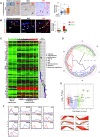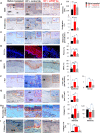Human organ rejuvenation by VEGF-A: Lessons from the skin
- PMID: 35749494
- PMCID: PMC9232104
- DOI: 10.1126/sciadv.abm6756
Human organ rejuvenation by VEGF-A: Lessons from the skin
Abstract
Transplanting aged human skin onto young SCID/beige mice morphologically rejuvenates the xenotransplants. This is accompanied by angiogenesis, epidermal repigmentation, and substantial improvements in key aging-associated biomarkers, including ß-galactosidase, p16ink4a, SIRT1, PGC1α, collagen 17A, and MMP1. Angiogenesis- and hypoxia-related pathways, namely, vascular endothelial growth factor A (VEGF-A) and HIF1A, are most up-regulated in rejuvenated human skin. This rejuvenation cascade, which can be prevented by VEGF-A-neutralizing antibodies, appears to be initiated by murine VEGF-A, which then up-regulates VEGF-A expression/secretion within aged human skin. While intradermally injected VEGF-loaded nanoparticles suffice to induce a molecular rejuvenation signature in aged human skin on old mice, VEGF-A treatment improves key aging parameters also in isolated, organ-cultured aged human skin, i.e., in the absence of functional skin vasculature, neural, or murine host inputs. This identifies VEGF-A as the first pharmacologically pliable master pathway for human organ rejuvenation in vivo and demonstrates the potential of our humanized mouse model for clinically relevant aging research.
Figures










References
-
- D. A. Sinclair, M. D. LaPlante, Lifespan: Why We Age—And Why We Don’t Have To (Atria Books, 2019).
-
- Mkrtchyan G. V., Abdelmohsen K. P., Andreux P., Bagdonaite I., Barzilai N., Brunak S., Cabreiro F., de Cabo R., Campisi J., Cuervo A. M., Demaria M., Ewald C. Y., Fang E. F., Faragher R., Ferrucci L., Freund A., Silva-García C. G., Georgievskaya A., Gladyshev V. N., Glass D. J., Gorbunova V., de Grey A., He W.-W., Hoeijmakers J., Hoffmann E., Horvath S., Houtkooper R. H., Jensen M. K., Jensen M. B., Kane A., Kassem M., de Keizer P., Kennedy B., Karsenty G., Lamming D. W., Lee K.-F., Aulay N. M., Mamoshina P., Mellon J., Molenaars M., Moskalev A., Mund A., Niedernhofer L., Osborne B., Pak H. H., Parkhitko A., Raimundo N., Rando T. A., Rasmussen L. J., Reis C., Riedel C. G., Franco-Romero A., Schumacher B., Sinclair D. A., Suh Y., Taub P. R., Toiber D., Treebak J. T., Valenzano D. R., Verdin E., Vijg J., Young S., Zhang L., Bakula D., Zhavoronkov A., Scheibye-Knudsen M., ARDD 2020: From aging mechanisms to interventions. Aging (Albany NY) 12, 24484–24503 (2020). - PMC - PubMed
-
- Schumacher B., Krieg T. M., The aging skin: From basic mechanisms to clinical applications. J. Invest. Dermatol. 141, 949–950 (2021). - PubMed
-
- Stone R. C., Aviv A., Paus R., Telomere dynamics and telomerase in the biology of hair follicles and their stem cells as a model for aging research. J. Invest. Dermatol. 141, 1031–1040 (2021). - PubMed
LinkOut - more resources
Full Text Sources
Other Literature Sources

